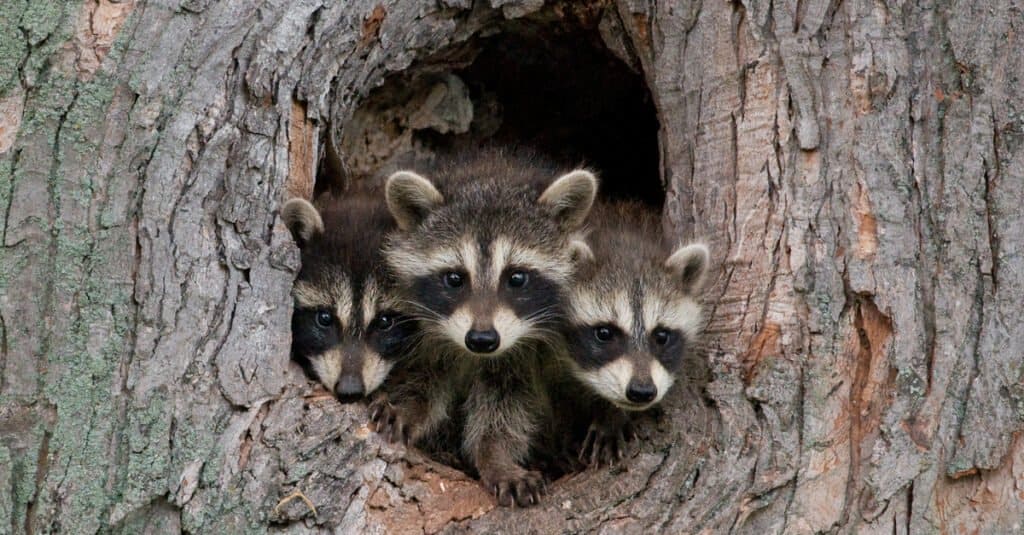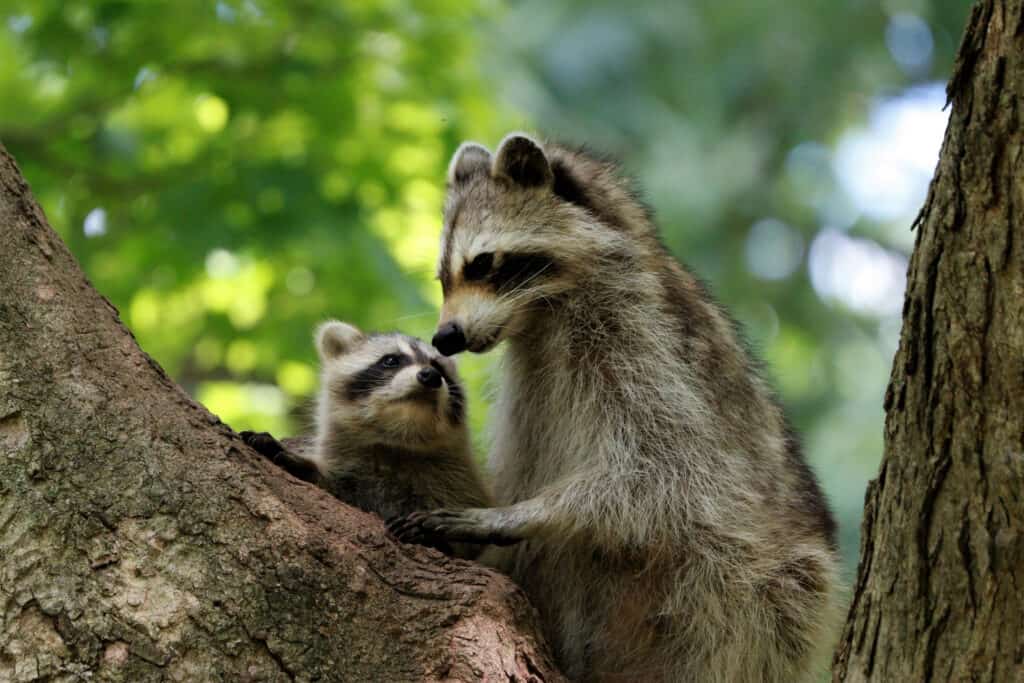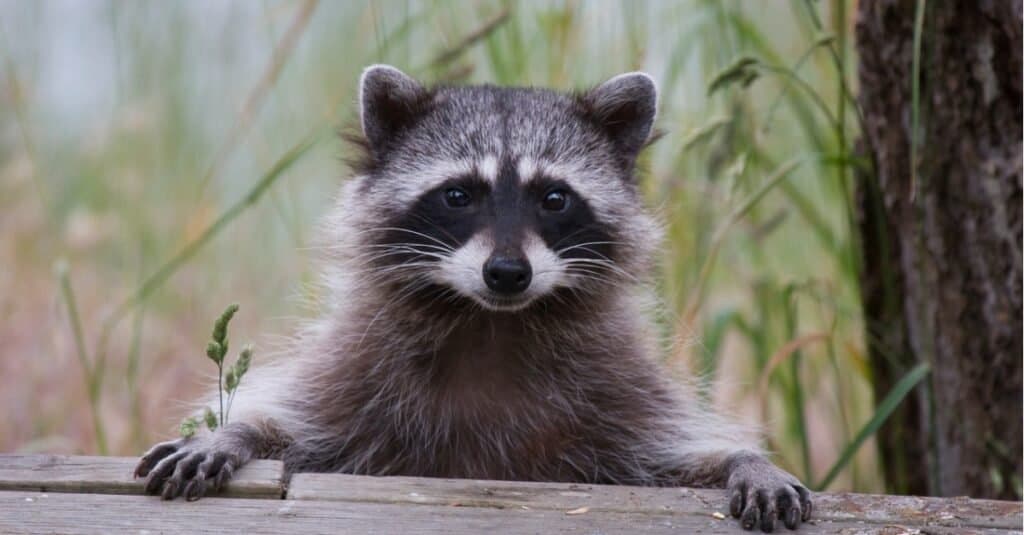Just How Big Do Raccoons Get? Weight, Length, and More!

©Gerald A. DeBoer/Shutterstock.com
There are seven species of raccoons, with the Northern Raccoon (Procyon lotor) being the most recognized species. The Northern Raccoon can be found in Canada, the United States, and South America. Northern raccoons have distinguishing black masks around their eyes that stop the glare of light from causing them to not be able to see.
Raccoons are nocturnal, meaning they prefer to move around during the night and to sleep and rest during the day. They can be found in wooded areas because they build dens in trees. They are excellent climbers. However, raccoons can be found living in urban communities, and they are opportunistic and will make their home in buildings, normally in the attic.
Birth To 1 Year
The mating season for raccoons happens late in the winter and early in the spring. The pregnant raccoon has a gestation period of 63 days. Thus, the babies are born between April and May. A mother raccoon will give birth to between two and six little ones, and they will only have one pregnancy each year.
At birth, a newborn raccoon (called a kit) weighs between 2 and 7 ounces. Raccoons are mammals, so kits drink mothers’ milk, and by the time they are 10 weeks of age, they will weigh close to 33 ounces. The newborn kit does not look like the adult raccoons. They are born covered in yellowish fur. At birth, they are blind and unable to fend for themselves.
Kits remain in the nest for the first three or four months of life without venturing outside. When they reach three or four months of age, they begin to leave the nest with their mother. The mother teaches her young to forage and the survival skills they need to know. Kits stay with their mom until they are 10 months old. By the time the kits are old enough to leave the nest, they will have developed the grey and black fur, and the distinguishing black facial mask around the eyes.
Juveniles 10 Months To 2 Years

©L-N/Shutterstock.com
These mammals do not develop emotional bonds with their mother or sibling. They are never around their father, and the mother raccoon protects and cares for the young ones, but when they wander away at ten months of age, she does not have an emotional reaction. Raccoons are solitary animals that live their lives alone most of the time.
The juvenile raccoon leaves their family and begins to forage for their own food and find their own home. They may live in trees, in abandoned burrows of other animals, in hollow logs, or in the attics of homes. When the kit leaves the care of their mother, they are called boars if they are male and sows if they are female. They will have reached a weight of three to five points by this time.
The raccoon juvenile is sexually mature and able to breed by the time they are one. Their size and weight will be determined by their health and the availability of food. A sick raccoon stays thin and does not grow to its full length for its species. Raccoons grow to be between 23″ and 37″. The animal’s tail will measure between 7.5″ and 16″.
Adults Ages 1 To 16
An adult raccoon can grow three feet from the tip of their nose to the tip of their tail. Raccoons living in captivity are often heavier than the animals in the wild. Captivity offers the animal a constant food supply, and if they begin to live in captivity before they reach their mature size, they will also grow to longer lengths.
The adults weigh between 14 and 23 pounds, depending on their diet, gender, and age. There have been raccoons that reached weights of 35 pounds. Raccoons living in captivity have been recorded as weighing 40, 50, and over 60 pounds. These extra-heavy animals get to be this size by eating unhealthy foods. Raccoons will eat almost anything. In the wild, most of their diet consists of invertebrates and plants. They eat fruits and nuts, fish, and most people food that they find.
Life-Span

©iStock.com/cullenphotos
The lifespan of a raccoon is influenced by where they live. In the wild most raccoons live between 2 and five years. They have a life expectancy of up to 16 years. In captivity raccoons have lived to be up to 20 years. The amount of care and protection from environmental factors like weather and unhealthy environments causes the captive animal to live longer than the wild animal.
FAQs (Frequently Asked Questions)
What should I do if I find a baby raccoon alone in the woods?
Rescuing an abandoned raccoon should only be done after you confirm that the baby needs rescuing. The mother raccoon often leaves her babies alone for several hours while she is out foraging for food. The mother can stay away for as long as a day. If you find a kit or a litter of kits alone, wait and watch to see if the mother returns before you touch or move the kits.
Are female raccoons bigger than the males?
The male raccoon is larger than the female. The average weight for this species ranges between 14 and 23 pounds, and the adult males will be a pound or two heavier than the females if they have had adequate food and nutrition. Adult males are also longer than the females.
Why do raccoons wash their food?
Raccoons do dip their food in water and this behavior has created the myth that the animals are washing their food. The truth is, that raccoons use their sense of touch to learn about their environment. They dip the food in water and they learn more about what they are eating, plus the moistened food is easier to eat and digest. They do not dip the food to clean it.









